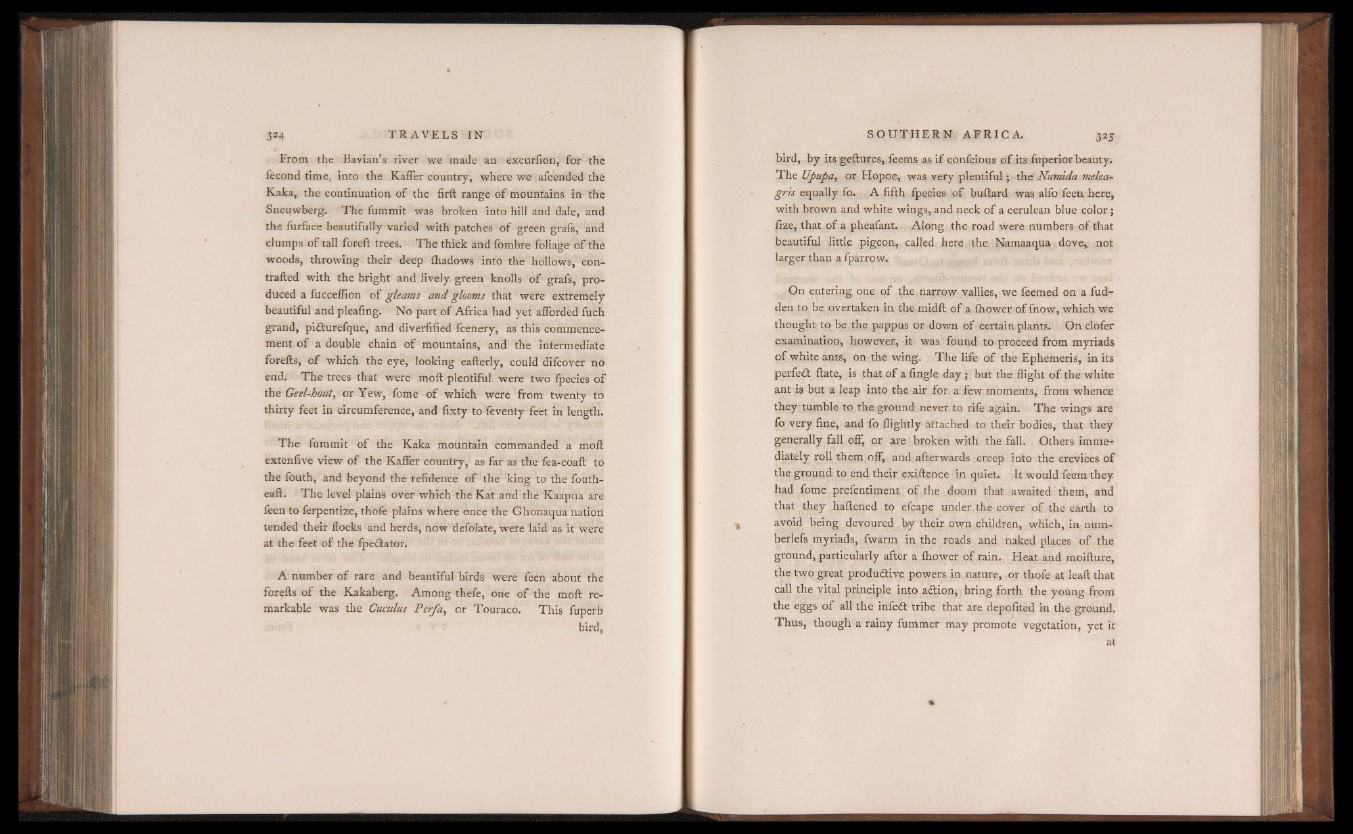
From the Bavian’s river we made an excurfion, for the
fecond time, into the Kaffer country, where we afcended the
Kaka, the continuation of the firft range of mountains in the
Sneuwberg. The fummit was broken into hill and dale, and
the furface beautifully varied with patches of green grafs, and
clumps of tall foreft trees. The thick and fombre foliage of the
woods, throwing their deep fhadows into the hollows, con-
trafted with the bright and lively green knolls o f grafs, produced
a fucceflion o f gleams and glooms that were extremely
beautiful and pleafing. No part of Africa had yet afforded fuch
grand, piCturefque, and diverfified fcenery, as this commencement
o f a double chain o f mountains, and the intermediate
forefts, o f which the eye, looking eafterly, could difcover no
end. The trees that were mod plentiful were two fpecies of
the Geel-bout, or Yew, fbme of which were from twenty to
thirty feet in circumference, and fixty to feventy feet in length.
The fummit of the Kaka mountain commanded a moft
extenfive view of the Kaffer country, as far as the fea-coaft to
the fouth, and beyond the refidence o f the king to the fbnth-
eaft. The level plains over which theKat and the Kaapna are
feen to ferpentize, thole plains where once the Ghonaqua nation
tended their flocks and herds, now defolate, were laid as it were
at the feet o f the fpeCtator.
A number of rare and beautiful birds were feen about the
forefts of the Kakaberg. Among thefe, one of the moft remarkable
was the Cuculus Per/a, or Touraco. This fuperb
bird,
bird, by its geftures, feems as if confcious o f its fuperior beauty.
The Upupa, or Hopoe, was very plentiful; the Numida melea-
gris equally fo. A fifth fpecies of buftard was alfo feen here,
with brown and white wings, and neck of a cerulean blue color;
fize, that of a pheafant. Along the road were numbers o f that
beautiful little pigeon, called here the Namaaqua dove,, not
larger than a fparrow.
On entering one of the narrow vallies, we feemed on a hidden
to be overtaken in the midft o f a fhower of fnow, which we
thought to be the pappus or down of certain plants. On clofer
examination, however, it was found to proceed from myriads
of white ants, on the wing. The life o f the Ephemeris, in its
perfedt ftate, is that of a fingle day; but the flight o f the white
ant is but a leap into the air for a few moments, from whence
they tumble to the ground never to rife again. The wings are
fo very fine, and fo flightly attached to their bodies, that they
generally fall off, or are broken with the fall. Others imme^
diately roll them off, and afterwards creep into the crevices o f
the ground to end their exiftence in quiet. It would feem they
had fome prefentiment of the doom that awaited them, and
that they haftened to efcape under the cover of the earth to
avoid being devoured by their own children, which, in num-
berlefs myriads, fwarm in the roads and naked places o f the
ground, particularly after a ihower o f rain. Heat and moifture,
the two great productive powers in nature, or thofe at leaft that
call the vital principle into aCtion, bring forth the young from
the eggs of all the infeCt tribe that are depofited in the ground.
Thus, though a rainy fummer may promote vegetation, yet it